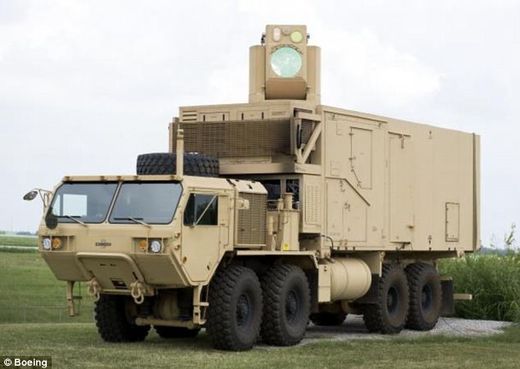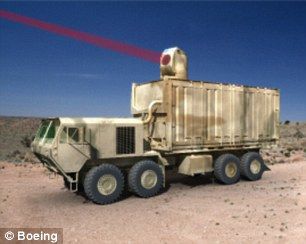
Boeing has announced that it has successfully mounted a 10kw solid-state laser on an eight-wheeled, 500-horsepower truck that could be used alongside conventional Army forces.
The High Energy Laser Mobile Demonstrator (HEL MD) is now ready for field testing and over the next year will have a chance to show off its ability to acquire, track and destroy targets.
The U.S. military has long hoped to develop a land-based, laser weapon that could be used to shoot down enemy missiles at the speed of light, but progress on the project has been slow.
It is hoped that the new weapon can be used to defend ground forces against rockets, artillery shells, missiles and unmanned drones by destroying threats with a beam of super-powered light energy.
U.S. and allied troops currently have limited options to defend against rockets, artillery or mortars. The short-range projectiles are airborne for only seconds, providing little time to take cover. And using heavy gunfire might inadvertently hit friendly forces in the process.
But HEL MD's laser beam, moving at the speed of light - approximately 186,000 miles per second - will hit targets with unprecedented precision and swiftness.

'High power testing represents a critical step forward for this innovative directed energy system.'
The latest field tests as part of Boeing's contract with the U.S. Army Space and Missile Defence Command. Blaine Beardsley, HEL MD program manager for Boeing, said: 'Phase II will allow us to build on the great work we have accomplished over the past several years with SMDC.
'Our team is eager to demonstrate that this revolutionary system is capable of saving lives and ready for the
The Pentagon has long been keen to develop laser weapons, and not just because of their ubiquity in science fiction.
Proponents of laser guns claim they are capable of incredible speed and precision coupled with relatively low cost and a seemingly near-infinite supply of 'ammo' constrained only by the availability of electricity.
However, developing weapons to the stage where they are ready for battlefield use has so far proved a challenge as researchers battle with problems like cooling, efficiency and miniaturisation.
In recent years other defence contractors including Raytheon and Northrop Grumman have demonstrated ship-mounted lasers capable of shooting down aircraft and disabling small boats.
The U.S. military has been experimenting with laser weapons since the Seventies but it is only in the past few years that a high-energy laser has properly functioned as a weapon.
Early systems used large, chemical-based lasers which tended to produce dangerous waste gases. More recently, scientists have developed solid state lasers that combine large numbers of compact beam generators, similar to LEDs.
The 10kw capacity of Boeing's latest effort is fairly modest compared with the power levels the Pentagon hopes to eventually achieve. The threshold for weapons-grade lasers is generally considered to be 100kw. Boeing said their system could 'subsequently' incorporate a more powerful laser.
VIDEO: U.S. Military begins testing on new laser device



It looks like it has room for people to drive it and shoot it. How 20th century is that? They need to make like a Mars automatic controlled rover so old men can kill with it from thousands of miles away. "The bravery of being out of range." Roger Water wrote this fine song on his great album, "Amused to Death". It comes to mind when I see something like a drone or the coming final production of this laser weapon.
Have a nice day.